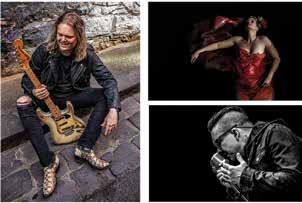Inclusive Fashion What is it and why should we care? BY NIKKI HIND
Inclusive Fashion. It’s like the fashion world’s version of an over played song on the radio; you can’t help but have heard of it. There’s a huge amount of talking about it, reporting on it, brands claiming they’re doing it, brands trying to do it, industry shows scrambling to prioritize it, social outrage at the lack of it, money being thrown at it, and customers wanting it. However, a quick search of the Internet reveals there is currently no definition of ‘Inclusive Fashion”; or even a general consensus on what it is. I have a particular interest in this topic. As Australia’s first blind fashion designer and the founder of Blind Grit – seemingly the world’s first fashion label built entirely of and around those who live with disability, I know what I believe ‘Inclusive Fashion’ is, and why I care deeply that we, as an industry, get it collectively correct. Although I am clearly coming from a disability perspective, I feel my overarching ideology is more around the powerfully innovative potential of diversity. Fashion is arguably our most powerful social communicator of what is alluring. Fashion has always been at the forefront of social inclusion movements; bestowing acceptance and prestige on cultures and sexualities that were previously vilified. Fashion overtly prescribes what’s desirable, and by omission, what’s not. So, human nature means many desperately want to see ourselves reflected in this Almighty Mirror Of Social Value. Late last year, I was lucky enough to be asked to join a panel of Adaptive Fashion leaders from around the world, at the National Ability Summit (NAS) in India. Varijia Bajaj created the Summit with the determined intention of not continually repeating historical learning curves, in terms of inclusion of persons with disabilities in the mainstream society.
Inclusive Fashion is certainly not a new concept. Stephanie Thomas, fellow NAS panellist and arguably the world’s leading Disability Fashion Stylist, says there are books on this topic dating back to the mid 50’s, that are just as relevant today as they were 65 years ago. In the 70’s Levi’s (Levi Stauss & Co) were part of the movement; and it was called ‘Functional Fashion’. So what are we not getting right as an industry ? Why are we constantly reinventing the Inclusive Fashion wheel ? To me, it feels like a no-brainer, that you need people with disabilities at the decision-making tables, at all levels of the fashion industry. We still have an inclusive fashion industry driven by creating fashion for people who live with disability, rather than with people who live with disability. Now, I realize that I appear to be getting Inclusive Fashion confused with Adaptive Fashion, but just hear me out. Throughout history disability & trauma have produced innate experts in creating resilience, being adaptive, problem solving, innovative thinking & meaningful, inclusive living, tempered by a deep connection with the human experience. Let me break this down into the three key flow-on benefits of having kick ass passionate, specialised disabled leaders at your decision-making tables, at all levels of the fashion industry: Disability leaders will bring in other diversity leaders because they understand the importance and potential. The disability community is still the most under -served by the fashion industry.
71






